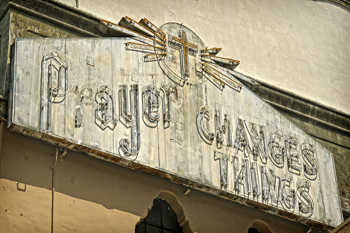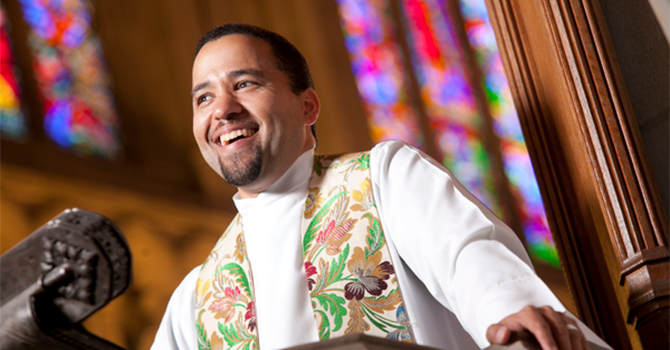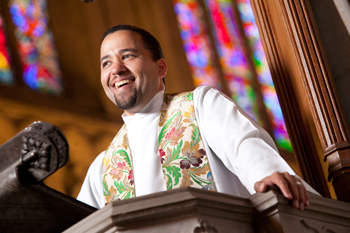Editor’s note: Faith & Leadership offers sermons that shed light on issues of Christian leadership. This sermon was originally preached at Duke’s Goodson Chapel on Feb. 2, 2012, for the Feast of the Presentation.
Malachi 3:1-4; Psalm 24:7-10; Hebrews 2:14-18; Luke 2:22-40
It is quite embarrassing. They just did not seem to “get it.” Perhaps it was because they were old. The old often fail to pick up -- or maybe just ignore -- the cultural cues those more attuned to the spirit of the age use to trigger the socially appropriate response to situations in which they find themselves.
Or it may be because they were -- how to put it delicately? -- so religious they failed to understand what the occasion required. I suppose we cannot help but think lives that have been spent waiting for the Messiah will not be exactly normal. Simeon does not sound like someone capable of delightful conversation. Anna may even be less scintillating than Simeon. Do you really want to know someone who, after the early death of her husband, has spent her life fasting and praying night and day in the temple?
Just think about it. If you had been in the temple when Mary and Joseph came with the baby Jesus, you would have known what to say. Like me, you would have blurted out, “What a cute baby!” Of course, we inhabit a very different culture and time than Mary, Joseph, Simeon and Anna, but I cannot help but believe that even in Palestine, even in a country occupied by the Romans, there would have been an equivalent response to our “What a cute baby!”
After all, we are human beings, and human beings -- even though we live in different times and in diverse cultures -- seem to share the judgment that most babies are cute. So how are we to account for Simeon’s and Anna’s failure to respond to this baby as we would expect? Why do they, ignoring all suggestion of cultural convention, see this baby Jesus as God’s long-awaited salvation for Israel?
I am, of course, having fun. But I begin this way to help us recognize how extraordinary it was that Simeon and Anna see that this baby is God’s salvation. What makes it possible to see salvation carried in the arms of Mary? Most of us would see a baby, but Simeon and Anna, guided by the Holy Spirit, see this baby named Jesus to be the long-awaited savior of Israel who will even be a light of revelation to the Gentiles. What makes it possible for Simeon and Anna to so see Jesus?
Rather than keep you in suspense, let me tell you what I take to be the difference between us -- that is, those of us who would have just seen a baby -- and Simeon and Anna, who saw salvation.
The difference is found in what Simeon says will happen through this baby: the glory of Israel will go as a light for revelation to the Gentiles. What is Israel’s glory? Israel’s glory is being God’s chosen people, a people who have been given the gifts of the law and the prophets in order to live as a holy people. Israel knows she has often betrayed God’s gifts, but Israel nonetheless is steadfast in her conviction that God’s salvation can be seen -- perhaps pre-eminently seen in the sacrifices enacted in the temple.
We are Gentiles. To be sure, we are Christian Gentiles, but we are not sure what to make of Israel’s presumption that salvation can be seen. We are tempted to think of salvation in terms of generalized ideals we think all humanity shares or should share rather than a salvation that is seen in the glory of Israel. We are not at all sure, therefore, we can or should be able to see salvation -- which means, I fear, we can no longer see Jesus as Simeon and Anna did.
In some liturgical calendars, the Feast of the Presentation brings an end to the season of Christmas. I suspect no season of the Christian year threatens more to drown the gospel in sentimentality than Christmas. This sentimentality, moreover, is often the result of our desire to have Jesus without the Jews. As Christians, we are tempted to think of Christmas as the beginning of the story; it is all too easy to forget that our celebration of Christ’s birth entails the claim that this child is the very one whom the Jews had long been waiting for.
Indeed, the proclamations of Simeon and Anna reaffirm and fulfill the prophecies that mark our Advent season of waiting and preparation. The long-awaited salvation of Israel -- and with it our own salvation -- is here, present in this child.
But salvation will come at a cost. The polarities of life and death mark each life, and this child is no different. If anything, death -- even agonizing death -- lingers around this child. Simeon’s aside to Mary indicates he is keenly aware of this.
Thus it is hardly a coincidence that the overarching context for today’s Gospel lesson is the sacrificial act of purification. From Malachi we read that God, being displeased with the lack of righteousness among his people, will be sending a messenger who, like a refiner’s fire, will “purify the descendants of Levi” so that they might “present offerings to the Lord in righteousness” (NRSV).
The liturgy of Psalm 24 asks, “Who shall ascend the hill of the Lord? And who shall stand in his holy place?” And the response given states, “Those who have clean hands and pure hearts, who do not lift up their souls to what is false, and do not swear deceitfully. They will receive blessing from the Lord, and vindication from the God of their salvation.”
Perhaps it is helpful to imagine the presentation as a scene not unlike the scenes we witness at infant baptisms. We tend to think the babies cry because of the ineptness of the minister or the temperature of the water. Yet it may well be that they are angered by what we do to them. Through baptism they are being subjected to a death. To be sure, it is a death that we believe gives life, but nonetheless, what they have undergone is a fearful business. The presentation of Christ in the temple is no less fearful.
Luke is intent on reminding us that the purification of Mary and Jesus is required by a law that reflects a history of life and death. “As it is written in the law of the Lord,” he tells us, “‘Every firstborn male shall be designated as holy to the Lord.’” And in Exodus 13, from which Luke is quoting, Moses instructs the people, in preparation for future generations, “When in the future your child asks you, ‘What does this mean?’ you shall answer, ‘By strength of hand the Lord brought us out of Egypt, from the house of slavery. When Pharaoh stubbornly refused to let us go, the Lord killed all the firstborn in the land of Egypt, from human firstborn to the firstborn of animals. Therefore I sacrifice to the Lord every male that first opens the womb, but every firstborn of my sons I redeem.’” This sacrificial act, therefore, is a reminder of the Lord’s mercy -- his redemption of Israel from her Egyptian oppressors.
Thus Mary presents herself with her son in the temple at Jerusalem 40 days after his birth so she and he may be purified as the law demands. The temple is where the priests of Israel (Simeon may even have been a priest) enact the sacrifices that God desires not only for the purification of sin but for the remembrance of God’s mercy to his people.
Being too poor to afford a lamb, Joseph and Mary sacrifice a pair of turtledoves or two young pigeons. In doing so they recognize the Lord’s mercy in accepting the sacrifice of these animals rather than the sacrifice of their firstborn son. While this particular act was not exceptional on the part of Mary and Joseph -- they were after all simply being faithful to the law -- this narrative of the presentation is a foreshadowing of the eventual self-sacrifice Jesus will perform on the cross.
In this initial sacrificial process, Jesus is consecrated to be for Israel -- and for us -- the great high priest, the Lamb of God, who will sacrifice himself so that we, Jew and Gentile, might become a light to the nations. We are told in Hebrews he did not come to help angels, but rather he came to help the descendants of Abraham, becoming in every respect like his brothers and sisters so that he might “be a merciful and faithful high priest in the service of God, to make a sacrifice of atonement for the sins of the people.” The presentation is the first step on the pathway to atonement.
Simeon and Anna are able to recognize who this baby is because their vision has been disciplined by faithful observance of Israel’s sacrificial life centered on the temple. That Simeon and Anna expect to see Israel’s salvation makes those of us who are Christians distinctly uncomfortable.
The Jewish challenge, “If Jesus has brought salvation, why does the world seem like it is all going to hell in a handbasket?” stings because we can’t deny the truthfulness of the observation that the state of the world hardly seems to validate our confession that salvation has come. We are even tempted to deny that it has, by instead fixating on Christ’s coming again.
We prefer to defer recognition by assuming we will see salvation when all has been judged and made right in the eschaton. But that is hardly the good news of the gospel! If we refuse to see salvation now, how can we expect to recognize it then? The question for us today is, Have we been disciplined enough by the sacramental life of the church to recognize Jesus when he is in our midst?
Simeon and Anna, schooled by the work of the Holy Spirit, are able to see that salvation is this baby who, as we are told in Hebrews, shares our flesh, our dying, so that the power of death might be destroyed, freeing us from the fear of death.
But their joyful proclamations do not invite a naive belief that salvation has put an end to conflict and struggle. For the God who saves by becoming one of us is the God who refuses to indulge our illusions that peace is won through control, manipulation and violence.
Rather, God comes to us as a baby, vulnerable and susceptible to the world’s fearsome grasp for power. That he does so means our fantasies of control will be exposed, our “inner thoughts revealed.” Herein is the conflict and struggle of working out our salvation. To recognize salvation in this child means admitting to ourselves that this is not the kind of salvation we desire.
To see salvation requires eyes trained to see sin so that when we present ourselves in the temple -- before God and neighbor -- we might do so with clean hands and clean hearts. This is why the prayer of confession rightly comes before the eucharistic celebration. The One whom we receive through the holy sacraments is the very One who, through the power of the Holy Spirit, cleanses us of sin so that we might behold him in his glory.
The story of Christ’s presentation and Simeon’s and Anna’s recognition is one we believe to be re-enacted through us today. For it is the same Holy Spirit that led Simeon to take the Christ child in his arms and proclaim, “My eyes have seen your salvation!” that leads us to take up the cup of salvation and bear witness to his sacrifice for us.
Therefore, sisters and brothers, let us confess our sins and ascend the hill of the Lord. For it is on the hill we have seen our salvation -- and the salvation of the world. Let us present ourselves to the Lord who in these sacraments presents himself to us once again. And by his mercy, in receiving these gifts, may we become one so that in us the world might see salvation.




















